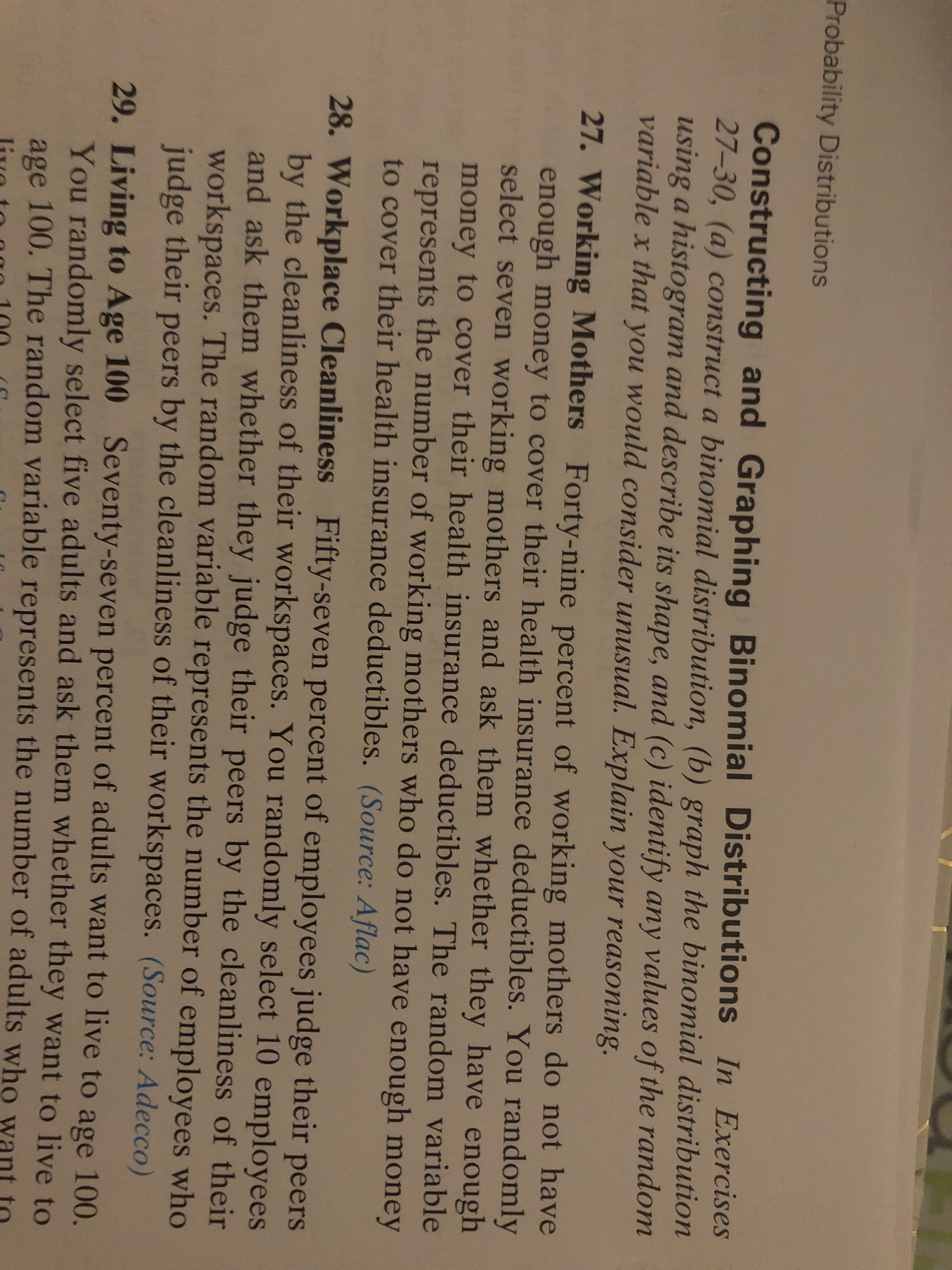Probability Distributions Constructing and Graphing Binomial Distributions In Exercises 27-30, (a) construct a binomial distribution, (b) graph the binomial distribution using a histogram and describe its shape, and (c) identify any values of the random variable x that you would consider unusual. Explain your reasoning. 27. Working Mothers Forty-nine percent of working mothers do not have enough money to cover their health insurance deductibles. You randomly select seven working mothers and ask them whether they have enough money to cover their health insurance deductibles. The random variable represents the number of working mothers who do not have enough money to cover their health insurance deductibles. (Source: Aflac) 28. Workplace Cleanliness Fifty-seven percent of employees judge their peers by the cleanliness of their workspaces. You randomly select 10 employe es and ask them whether they judge their peers by the cleanliness of their workspaces. The random variable represents the number of employees who judge their peers by the cleanliness of their workspaces. (Source: Adecco) 29. Living to Age 100 Seventy-seven percent of adults want to live to age 100. You randomly select five adults and ask them whether they want to live to age 100. The random variable represents the number of adults who
Probability Distributions Constructing and Graphing Binomial Distributions In Exercises 27-30, (a) construct a binomial distribution, (b) graph the binomial distribution using a histogram and describe its shape, and (c) identify any values of the random variable x that you would consider unusual. Explain your reasoning. 27. Working Mothers Forty-nine percent of working mothers do not have enough money to cover their health insurance deductibles. You randomly select seven working mothers and ask them whether they have enough money to cover their health insurance deductibles. The random variable represents the number of working mothers who do not have enough money to cover their health insurance deductibles. (Source: Aflac) 28. Workplace Cleanliness Fifty-seven percent of employees judge their peers by the cleanliness of their workspaces. You randomly select 10 employe es and ask them whether they judge their peers by the cleanliness of their workspaces. The random variable represents the number of employees who judge their peers by the cleanliness of their workspaces. (Source: Adecco) 29. Living to Age 100 Seventy-seven percent of adults want to live to age 100. You randomly select five adults and ask them whether they want to live to age 100. The random variable represents the number of adults who
MATLAB: An Introduction with Applications
6th Edition
ISBN:9781119256830
Author:Amos Gilat
Publisher:Amos Gilat
Chapter1: Starting With Matlab
Section: Chapter Questions
Problem 1P
Related questions
Question
How am I able to do problem 27(a) on a TI-83 Plus calculator?

Transcribed Image Text:Probability Distributions
Constructing and Graphing Binomial Distributions In Exercises
27-30, (a) construct a binomial distribution, (b) graph the binomial distribution
using a histogram and describe its shape, and (c) identify any values of the random
variable x that you would consider unusual. Explain your reasoning.
27. Working Mothers Forty-nine percent of working mothers do not have
enough money to cover their health insurance deductibles. You randomly
select seven working mothers and ask them whether they have enough
money to cover their health insurance deductibles. The random variable
represents the number of working mothers who do not have enough money
to cover their health insurance deductibles. (Source: Aflac)
28. Workplace Cleanliness Fifty-seven percent of employees judge their peers
by the cleanliness of their workspaces. You randomly select 10 employe es
and ask them whether they judge their peers by the cleanliness of their
workspaces. The random variable represents the number of employees who
judge their peers by the cleanliness of their workspaces. (Source: Adecco)
29. Living to Age 100 Seventy-seven percent of adults want to live to age 100.
You randomly select five adults and ask them whether they want to live to
age 100. The random variable represents the number of adults who
Expert Solution
This question has been solved!
Explore an expertly crafted, step-by-step solution for a thorough understanding of key concepts.
This is a popular solution!
Trending now
This is a popular solution!
Step by step
Solved in 2 steps

Knowledge Booster
Learn more about
Need a deep-dive on the concept behind this application? Look no further. Learn more about this topic, statistics and related others by exploring similar questions and additional content below.Recommended textbooks for you

MATLAB: An Introduction with Applications
Statistics
ISBN:
9781119256830
Author:
Amos Gilat
Publisher:
John Wiley & Sons Inc

Probability and Statistics for Engineering and th…
Statistics
ISBN:
9781305251809
Author:
Jay L. Devore
Publisher:
Cengage Learning

Statistics for The Behavioral Sciences (MindTap C…
Statistics
ISBN:
9781305504912
Author:
Frederick J Gravetter, Larry B. Wallnau
Publisher:
Cengage Learning

MATLAB: An Introduction with Applications
Statistics
ISBN:
9781119256830
Author:
Amos Gilat
Publisher:
John Wiley & Sons Inc

Probability and Statistics for Engineering and th…
Statistics
ISBN:
9781305251809
Author:
Jay L. Devore
Publisher:
Cengage Learning

Statistics for The Behavioral Sciences (MindTap C…
Statistics
ISBN:
9781305504912
Author:
Frederick J Gravetter, Larry B. Wallnau
Publisher:
Cengage Learning

Elementary Statistics: Picturing the World (7th E…
Statistics
ISBN:
9780134683416
Author:
Ron Larson, Betsy Farber
Publisher:
PEARSON

The Basic Practice of Statistics
Statistics
ISBN:
9781319042578
Author:
David S. Moore, William I. Notz, Michael A. Fligner
Publisher:
W. H. Freeman

Introduction to the Practice of Statistics
Statistics
ISBN:
9781319013387
Author:
David S. Moore, George P. McCabe, Bruce A. Craig
Publisher:
W. H. Freeman